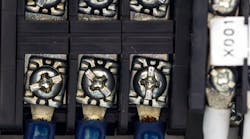Most energy savings efforts focus on big items such as lighting and motors. Although that focus may produce spectacular results, you also must keep in mind that little things add up, too. The phrase “death by 1,000 cuts” is a good one to keep in mind when looking for energy savings.
How many screw terminal terminations do you have in your plant? Each of those contains multiple points of potential energy waste:
- Spade lug improperly crimped.
- Metal interfaces not clean.
- Termination incorrectly torqued.
If you have all of these problems to a minor degree on only one termination, it might not be worth making the effort to even find that rogue terminal. But these problems are very common. If you have one or more of them on 1,000 terminals throughout the facility, the problem is now several orders of magnitude larger. You’ve got a real problem; it’s just dispersed across many points.
Having a qualified thermographer conduct a thermographic survey, analyze the results, and prepare a report is the most efficient way to get started on solving this problem. The typical solution, however, does not solve the symptoms or the causes of these tiny energy vampires. The typical solution is to just tighten all of the connections.
Some that were loose will probably pass the subsequent thermographic analysis. But why were they loose? What steps did you take to ensure that they now are clean and properly assembled so they don’t come loose again?
Some that were not loose but still showed up as suspect will show up as suspect again. Tightening them, in fact, is likely to exceed their torque limit so that in addition to having a dirty interface or bad crimp on the lug, they will have a loose terminal connection.
The thermographic analysis doesn’t show you which screws are loose. It shows you where a given connection produces more heat than similar connections.
You can use a low-ohm tester to examine each connection more closely and take “before” condition data before repairing suspect connections. This step is optional, but advisable because it will reveal patterns and also eliminate repairing connections that weren’t faulty to begin with.
To repair a connection, replace any locking hardware (e.g., split ring washer), clean the mating surfaces, and tighten to the recommended torque using a calibrated torque screwdriver or wrench. Then measure the connection with your low-ohm tester. This measurement, like the other one, is optional but advisable. It gives you “as left” condition data and a baseline measurement for the future.
A plant with thousands of terminal connections can save significant energy when you make sure that those are good connections, especially if those connections are in air-conditioned spaces. This effort also increases reliability, regardless of where the connections are situated.




